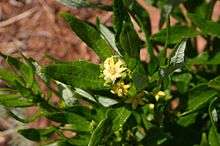Fadogia homblei
| Fadogia homblei | |
|---|---|
 | |
| Scientific classification | |
| Kingdom: | Plantae |
| (unranked): | Angiosperms |
| (unranked): | Eudicots |
| (unranked): | Asterids |
| Order: | Gentianales |
| Family: | Rubiaceae |
| Genus: | Fadogia |
| Species: | F. homblei |
| Binomial name | |
| Fadogia homblei De Wild. | |

Fadogia homblei De Wild. is a 60 cm tall erect perennial Sub-Saharan shrublet with subterranean stems producing unbranched annual shoots, and is one of some 47 species of Fadogia belonging to the family of Rubiaceae. It occurs in Angola, Tanzania, Malawi, Mozambique, Zambia, Zimbabwe, and in Limpopo and Gauteng Provinces in South Africa.[1]
This species has leaves in whorls of 3-5. The leaves are elliptic or lanceolate, shiny above, with greyish-white papillose hairs on the undersurface. Fragrant flowers are in 3-5-flowered whorls arising from the leaf nodes, and are creamy yellow to bright yellow in colour. The fruit is spherical, crowned with the persistent calyx limb, initially green, but turning black when ripe, and is edible.[2]
Browsing of this species has long been known to cause 'gousiekte' ("quick disease"), a cardiotoxicosis of ruminants marked by heart failure four to eight weeks after ingestion of certain species of Vangueria, Pavetta and Fadogia, and is thought to be caused by the polyamine, pavettamine. All six plants known to cause gousiekte are members of the Rubiaceae family.[3] Laboratory analysis revealed that the pavettamine concentration in Fadogia homblei was highest in the topmost leaf pair, and decreased towards the base of the plant. All the gousiekte-causing plants have symbiotic bacteria in their leaves, and at first these were suspected of playing a role in the production of pavettamine. However cultures of the bacteria have not revealed any traces of pavettamine, showing that the toxin is either from an interaction with the plant or solely produced by the plant.[4] The structure of pavettamine remained elusive, but was finally published in 2010 by Bode et al., some 15 years after it was first isolated, and found to be (2S,4R,8R,10S)-1,11-diamino-6-aza-undecane-2,4,8,10-tetraol. Despite the determination of pavettamine's structure it has yet to be linked to gousiekte.[5]
A large number of compounds were isolated from the fruits, leaves and stem of the species, including:
- Scopoletin anti-fungal, anti-spasmodic, anti-oxidant, anti-inflammatory and anti-cancer.
- Luteolin anti-mutagenic, anti-tumor, anti-oxidant and anti-inflammatory.
- Quercetin 3-O-β-D-galactoside is common in plants and an active ingredient of many herbal remedies, anti-hypertensive, vasodilatory.
- Lupeol anti-oxidant, anti-angiogenic, anti-neoplastic, anti-inflammatory and anti-malarial.
- Betulinic acid anti-inflammatory, in vitro anti-malarial, anti-HIV and anti-cancer.
- Sitosterol and stigmasterol common compounds found in almost all plant species.
- Pinoresinol inhibitor of 15-lipoxygenase.
- Uracil was isolated from the leaf of Fadogia homblei, significant as the first finding of uracil from plants other than ferns.
Synonyms
- Fadogia monticola Robyns
- Fadogia oleoides Robyns [6]
References
- ↑ http://www.zimbabweflora.co.zw/speciesdata/species.php?species_id=156130
- ↑ http://www.ilcpa.pl/?s=Chemical+Constituents+from+Fadogia+homblei
- ↑ http://repository.up.ac.za/handle/2263/1732/browse?value=Pavettamine&type=subject
- ↑ Van Elst, D; van Wyk, B; Schultz, A; Prinsen, E (2013). "Production of toxic pavettamine and pavettamine conjugates in the gousiekte-causing Fadogia homblei plant and its relation to the bacterial endosymbiont". Phytochemistry. 85: 92–8. doi:10.1016/j.phytochem.2012.08.025. PMID 23009874.
- ↑ http://www.ilcpa.pl/wp-content/uploads/2012/11/ILCPA-92-2013-116-1241.pdf
- ↑ http://www.theplantlist.org/tpl1.1/record/kew-83682
External links
- Dressler, S.; Schmidt, M. & Zizka, G. (2014). [http://www.africanplants.senckenberg.de/root/index.php?submitForm=true&page_id=77&searchTextMenue=Fadogia+homblei&filterRegionIDs[]=6&filterRegionIDs[]=1&filterRegionIDs[]=2&filterRegionIDs[]=3&filterRegionIDs[]=5 "Fadogia homblei"]. African plants – a Photo Guide. Frankfurt/Main: Forschungsinstitut Senckenberg.